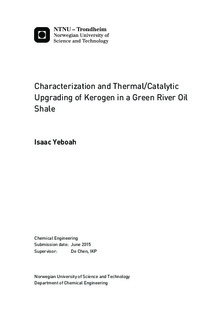Characterization and Thermal/Catalytic Upgrading of Kerogen in a Green River Oil Shale
Master thesis
Permanent lenke
http://hdl.handle.net/11250/2351702Utgivelsesdato
2015Metadata
Vis full innførselSamlinger
Sammendrag
Comprehensive structural characterization of oil shale (kerogen) and subsequent upgrading to fuels are of paramount scientific and industrial importance, calling for a better understanding. In this work, an oil shale from Green River formation was employed and characterized by multiple techniques such as Rock-Eval pyrolysis, TOC, XRD, FTIR and TGA-MS. It is found that the inorganic matter were mainly calcite, dolomite and Fe-doped quartz, while the organic matter consists of soluble bitumen and insoluble kerogen. The kerogen belongs to Type I, and locates in the oil window with excellent maturity. Subsequently CH2Cl2 was used as extractant to separate bitumen, and the as-extracted oil shale was treated with HCl to remove carbonates which might interfere with the subsequent analysis for the thermal upgrading of kerogen to fuel. The contents of bitumen and kerogen are 3.67% and 27.56%, respectively. TGA measurements showed that bitumen and kerogen have overlapping thermal behaviors, strongly indicating the necessity of bitumen pre-extraction. Thermally produced fuel yields of bitumen and kerogen are 96% and 79% respectively. The H/C ratios of bitumen and kerogen were aliphatic in nature and have a linear hydrocarbon pyrolyzates within the range of C3-C35. Furthermore, various catalysts such as mineral acids, in-situ formed metal oxides and metal chlorides were tested for the kerogen conversion. Among them, CuCl2◦2H2O is the most active. Its fuel produced is shifted towards diesel yield and slightly higher than bitumen diesel yield. Its apparent activation energy and pre-exponential factor are ca.78 kJ/mol and 3.6e+19 sec-1 respectively whereas those of un-catalyzed reaction of kerogen are ca. 98 kJ/mol and 1.4e+24 sec-1 respectively.
Keywords: Oil shale; Kerogen utilization; Characterization; Thermal upgrading; Catalytic upgrading; Fuels; Activation energy
